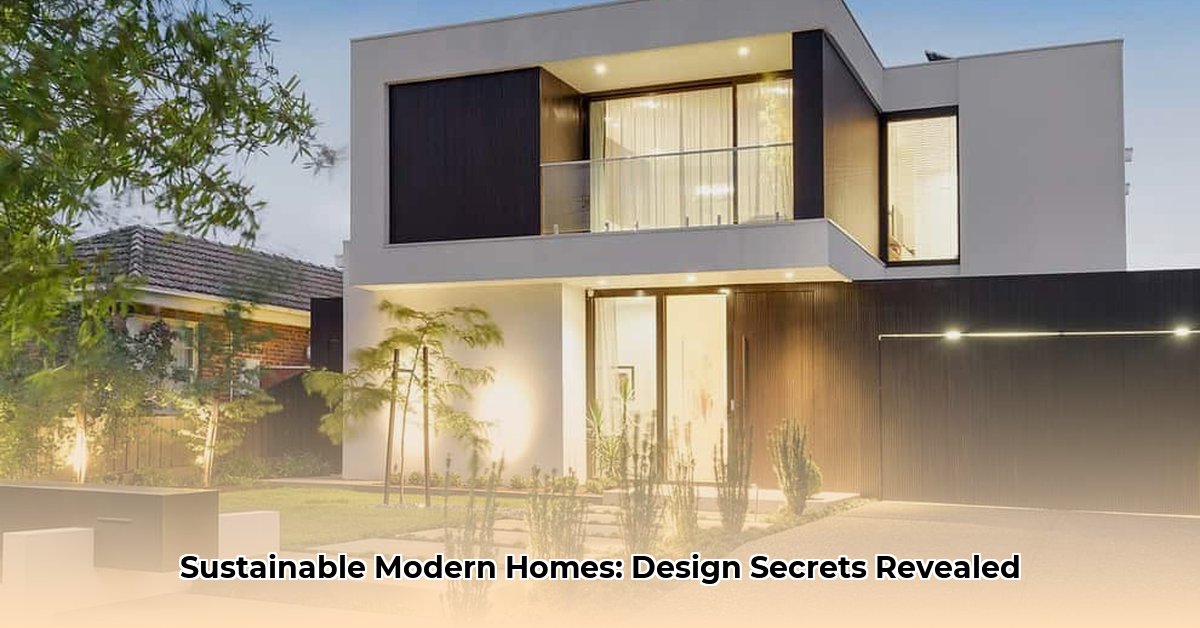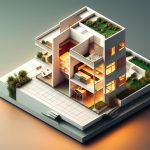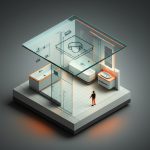Want a home that’s both beautiful and eco-friendly? This guide is your roadmap to designing a modern floor plan that’s perfect for you. We’ll explore the latest trends in modern home design, showcasing various styles and helping you understand their distinct characteristics. We’ll also cover the practical aspects—selecting sustainable materials, integrating smart technology, and tackling potential challenges. Whether collaborating with an architect or managing the project independently, we’ll equip you with the insights and guidance needed to build the modern, sustainable home of your dreams. For more floor plan ideas, check out these house floor plans.
Modern Floor Plan Concepts: Shaping Sustainable Homes
Designing your dream home? Modern floor plans offer a fantastic fusion of style and practicality, making them incredibly desirable. But what constitutes a modern floor plan? Let’s delve into innovative home layouts tailored for sustainable living!
Exploring Modern Design Principles: The Essence of Modern Living & Open Concept Designs
Modern floor plans transcend mere trendy aesthetics; they focus on creating a home that is both visually appealing and highly functional. Envision open spaces that maximize the flow of natural light, creating an airy ambiance. Clean lines and simplified forms take precedence, minimizing clutter and enhancing the sense of spaciousness. Imagine waking up to sunlight flooding through expansive windows, illuminating a bright, airy kitchen seamlessly connected to a welcoming living room. That’s the allure of modern design—a seamless harmony of form and function. It’s about crafting a space that feels both sophisticated and effortlessly comfortable with flexible arrangements. The emphasis is on adaptability, allowing the home to evolve with the changing needs of its occupants.
Modern Floor Plan Variations: Discovering Your Ideal Style Through Interior Design
The beauty of modern design lies in its versatility – it’s not a rigid, one-size-fits-all solution. Several distinct styles fall under the modern umbrella, each offering a unique personality:
- Minimalist: Embraces clean lines, neutral color schemes, and a strong emphasis on functionality. Clutter is actively discouraged! Every item should have a clear purpose and a designated place. The overall atmosphere is serene and uncluttered.
- Farmhouse Modern: Seamlessly blends rustic charm with contemporary conveniences. Envision exposed beams, reclaimed wood accents, and a welcoming fireplace, all complemented by sleek cabinetry and minimalist furnishings. The result is a home that feels both classic and contemporary.
- Industrial Modern: Celebrates raw materials like exposed brick, metal accents, and open shelving. It’s a style for those who appreciate an edgy, urban aesthetic. Think exposed ductwork and polished concrete floors—a captivating contrast to the sleek, modern lines of the space.
- Mid-Century Modern: Echoing styles popularized in the 1950s and 60s, it features clean lines, organic shapes, and a focus on natural materials. It often integrates bold colors and geometric patterns, creating a visually stimulating and calming environment.
- Scandinavian Modern: Prioritizes functionality, simplicity, and a connection to nature. Light wood tones, neutral palettes, and cozy textures create a warm and inviting atmosphere. Emphasis is placed on natural light and creating a sense of hygge (coziness and contentment).
These examples merely scratch the surface; the variations are virtually endless! The key lies in selecting a style that genuinely reflects your unique personality and lifestyle. Explore home design publications and online resources to gather inspiration; consider what elements resonate with you, and let that guide your decisions.
Sustainability and Smart Home Integration: Building for a Brighter Future with Energy-Efficient Appliances
Creating a modern home extends beyond aesthetics; it’s about building a sustainable and technologically advanced living space. Incorporating sustainable materials and smart home technology represents more than just a trendy upgrade; it’s a strategic investment in your future. Imagine solar panels quietly generating clean energy, smart thermostats intuitively adjusting energy usage based on your preferences, and energy-efficient appliances minimizing your environmental footprint.
Here’s an overview of the advantages and potential drawbacks:
| Feature | Pros | Cons |
|---|---|---|
| Sustainable Materials | Reduced environmental impact, enhanced indoor air quality, potential for increased durability, often aesthetically pleasing, promotes responsible resource management. | Higher initial costs, potential limitations in availability of specific materials, may require specialized installation techniques, potential for longer lead times in procurement. |
| Smart Home Technology | Increased energy efficiency through automated controls, enhanced security features for peace of mind, improved convenience and comfort, remote monitoring and management. | Higher initial investment, potential for technical malfunctions requiring specialized support, concerns about data privacy and security, reliance on stable internet connectivity. |
The upfront investment in sustainable materials and smart technology might seem substantial, but the long-term savings on utility bills and reduced environmental impact can potentially outweigh the initial costs. It’s an investment in your comfort and the well-being of the planet.
According to the U.S. Department of Energy, homes with smart thermostats can realize up to a 15% reduction in heating and cooling expenses. Are you ready to embrace energy efficiency for your home?
Planning Your Modern Home: A Step-by-Step Guide for Homeowners
Building your dream home requires meticulous planning. This process involves several key steps, tailored slightly depending on your role to create an effortless process for everyone involved:
For Homeowners:
- Define Your Needs and Vision: Before engaging with an architect, dedicate time to visualizing your ideal home. What are your priorities – open-concept living, energy efficiency, or advanced smart-home integration? Creating a mood board can help you create clarity.
- Find a Qualified Architect: Research architects with a proven track record in modern design and a clear understanding of your aesthetic. Review their portfolios, read testimonials, and schedule consultations. Effective communication is crucial.
- Develop a Realistic Budget: Modern homes can vary significantly in price. Collaborate with your architect to establish a detailed budget that encompasses construction, materials, permits, and professional fees. Prepare for potential cost adjustments and establish a contingency fund.
- Choose Sustainable Materials Wisely: Explore eco-conscious options such as bamboo flooring, reclaimed wood, recycled glass countertops, and low-VOC paints. Assess their durability and maintenance requirements.
- Integrate Smart Home Features Strategically: Determine essential smart-home features and differentiate them from non-essential additions.
For Architects:
- Prioritize Energy Efficiency in Your Designs: Integrate passive solar design principles, natural ventilation strategies, and high-performance insulation to minimize energy consumption. Conduct energy modeling to predict building performance.
- Source Sustainable Materials Responsibly: Research and select sustainable materials while considering their availability, cost-effectiveness, and broader environmental impact. Seek materials with certifications such as LEED or Cradle to Cradle.
- Integrate Smart Technology Seamlessly: Design systems that are user-friendly, reliable, and energy-efficient. Anticipate future technological advancements to guarantee the adaptability of your designs.
- Focus on Adaptable Designs: Develop floor plans that can easily accommodate future lifestyle adjustments. Design flexible spaces that can serve multiple functions.
For Builders:
- Master Sustainable Building Practices: Stay informed about the latest energy-efficient construction techniques and materials. Obtain certifications such as LEED AP or Passive House Builder.
- Establish Relationships with Sustainable Suppliers: Cultivate strong relationships with reputable suppliers of sustainable materials to ensure dependable sourcing.
- Develop Expertise in Smart Home Integration: Acquire the skills or partner with specialists to ensure the proper installation and configuration of smart-home systems. Provide training to homeowners on system operation.
Addressing Common Challenges and Misconceptions
While modern design offers many advantages, potential challenges must be addressed. Let’s explore common concerns to ensure informed decision-making:
- Balancing Open Concept and Privacy: Concerns may arise that open-concept designs compromise privacy. Strategic zoning, thoughtfully positioned room dividers, or strategic furniture arrangements can mitigate these concerns.
- Managing Costs: Modern materials and advanced technology can increase expenses. However, by carefully selecting materials and prioritizing essential features, you can achieve a stunning modern home within a reasonable budget.
Checklist for Sustainable Material Selection
Choosing eco-friendly materials is essential for creating a sustainable home. Here’s a quick checklist to guide your selections:
| Material | Sustainability Considerations | Cost Considerations |
|---|---|---|
| Bamboo Flooring | Rapidly renewable resource, low-impact harvesting methods, durable, aesthetically appealing. | Moderate to high, depending on quality, source, and processing methods. |
| Reclaimed Wood | Reduces landfill waste, offers unique character and aesthetic, promotes responsible forestry practices. | Can be high, particularly for rare or antique woods; labor costs for preparation and installation can add up. |
| Recycled Glass | Diverts waste from landfills, durable, unique aesthetic, reduces the need for virgin materials in manufacturing. | Can be more expensive than conventional materials, depending on production processes and design complexity. |
| Cork Flooring | Sustainable harvesting practices, renewable resource, naturally insulating, comfortable underfoot. | Moderate cost, requires specific maintenance with appropriate sealants and cleaning products. |
| Sheep’s Wool Insulation | Excellent thermal properties, naturally flame retardant without chemical treatments, biodegradable, non-toxic, reduces energy consumption. | Initially |
- Gray Kitchen Backsplash Ideas: Find Your Perfect Gray Tile - December 11, 2025
- Glass Wall Tiles For Bathroom: A Stylish, Durable Choice - December 10, 2025
- Glass Mosaic Kitchen Backsplash: Add Shimmer and Style - December 9, 2025









